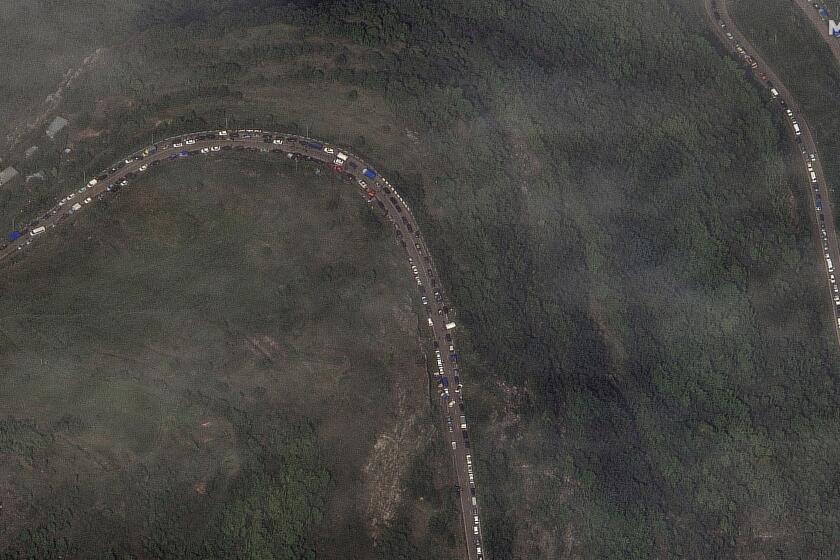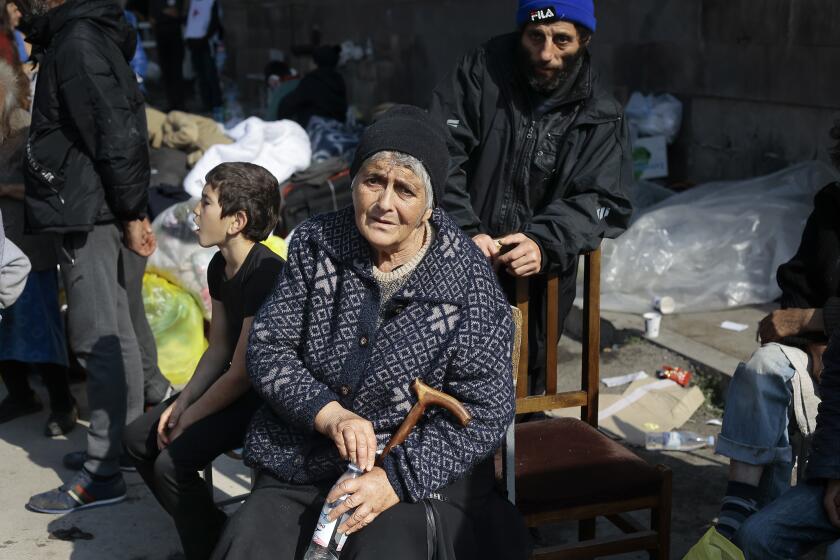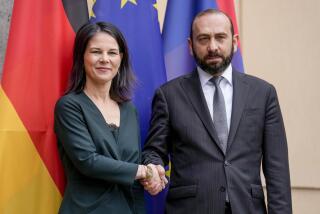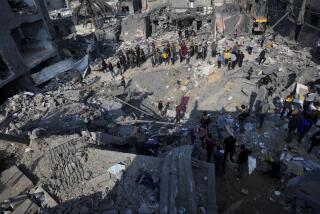Opinion: How lies on paper enabled Azerbaijan’s destruction of an Armenian community
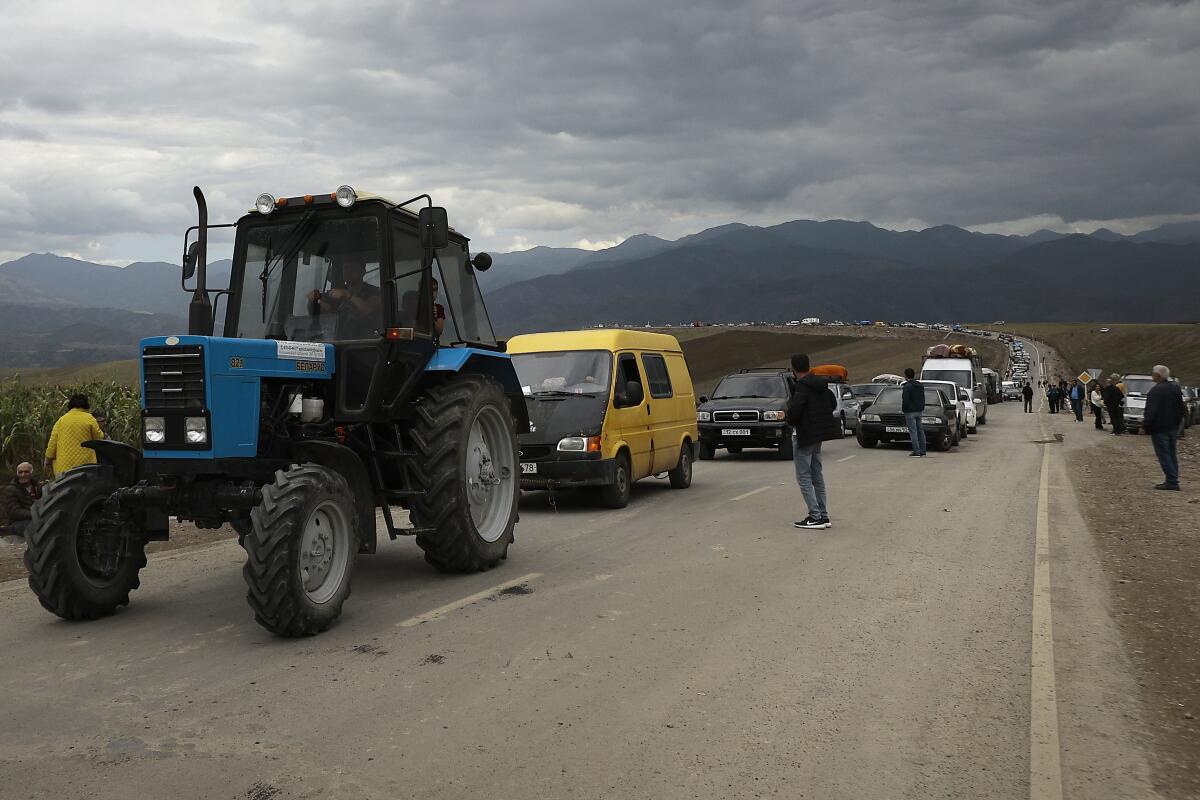
- Share via
My mother has two birth dates: the one on her passport, and then the real one. She was born in January in the late ’60s in Beirut, Lebanon. But because her birth was not registered for another 10 weeks, official documents give a date in March. With every phone call she places to the bank or prescription she picks up at the pharmacy, when she is asked for a date of birth to confirm her identity, she is forced to confirm a falsehood.
Immigrant families like mine understand that what’s on paper is not always the truth. Sometimes paper tells little fibs, like my mother’s birth date, and sometimes paper tells monstrous lies that affect millions of people.
For the last century, Turkey has employed the power of paper to deny the Armenian genocide. Turkish history textbooks teach young students that there was no genocide; rather, the Turks were victims of Armenian aggression, leaving them with no choice but to target the traitors conspiring against them. One Turkish textbook estimates a death toll of 57,000 Armenians. Although the real number will never be known, historians put it at around 1.5 million.
Azerbaijan’s talking points about the assault on the Artsakh republic are not credible. It’s vital to recognize what’s really happening in the South Caucuses.
This history of violence is being repeated today. Yet many people know nothing about Azerbaijan’s recent attacks against Armenians in the Caucasus because, for the last four years, the limited coverage has often misrepresented the truth.
In 2020, with Turkey’s support, Azerbaijan began the latest genocidal campaign against the Armenians, this time in the territory of Artsakh, also known as Nagorno-Karabakh. Although this autonomous region was inhabited and controlled by Armenians, who the land belonged to was contested on paper.
Claiming this land as theirs, Azerbaijan beheaded civilians. It blasted residential areas with cluster munitions. Even after a cease-fire was called in November 2020, attacks continued and tensions escalated. Then, starting in December 2022, Azerbaijan trapped and starved the men, women and children of Artsakh in an illegal blockade, cutting off access to food, medicine and humanitarian aid. In September, after nine months of psychological and physical torment, Azerbaijan launched a final attack that would force the region to surrender and its Armenian population to flee, in effect ethnically cleansing Artsakh of its people.
While the Armenians of Artsakh documented and shared the horrors of their mass exodus on social media, Armenians in the diaspora witnessed their suffering and watched — in real time — a modern reiteration of death marches our ancestors had trekked. Meanwhile, the international community failed to see beyond what they were told on paper.
Much of the little concurrent reporting done on this conflict — reporting that has largely vanished in the past year — would include some version of the misleading statement that Artsakh is internationally recognized as Azerbaijan. In other words, among the first facts often established by the media on Artsakh is that the land belongs to Azerbaijan on paper, establishing a sense of justification for their violence.
Armenia and Azerbaijan move toward normalizing relations after a bitter conflict over the Nagorno-Karabakh region, which Armenians call Artsakh.
The statement is deceptive; it is true but it is not the truth. In the 1920s, although the population of Artsakh was 90% Armenian, the USSR debated which Soviet republic the region would be officially aligned with. Armenia was poor and faced a refugee crisis following the Armenian genocide, while Azerbaijan sat on vast reserves of oil. So the Soviets prioritized economy rather than autonomy.
For decades, Armenians petitioned to change the demarcation of these borders. More than 100,000 protested, demanding recognition of Artsakh as Armenia. They were denied changes due to fear of inciting other border adjustment demands by nations throughout the Soviet Union. When the USSR collapsed in 1991, war erupted in Artsakh between the majority ethnic Armenian population and Azerbaijan. The war went on for years, killing more than 30,000 people on both sides, until ultimately, Armenia won. Yet still, the borders did not change on paper. Despite being inhabited and controlled by Armenians, and operated as an unofficial extension of Armenia, Artsakh remained “internationally recognized as Azerbaijan.”
Since its military loss in the ‘90s, Azerbaijan has employed a state-sponsored campaign of cultural erasure resembling the tactics of Turkey. In Azerbaijani literature, positive references to Armenia or Armenians have been removed. It’s as if we cannot exist in Azerbaijan, not even as fictional characters.
And now, we can no longer exist in Artsakh. In September, a decree was signed stating that the region would dissolve itself and cease to exist starting Jan. 1, 2024. Today, the Armenian territory of Artsakh no longer exists on paper.
With Artsakh in its possession, Azerbaijan has come closer to achieving shared goals with Turkey. If you look at a map, you’ll see that the only thing standing between Azerbaijan and Turkey, on paper and land, is Armenia and, so, Armenians. Officials in these countries have described Turks and Azeris as “one nation, two states,” which explains their long-standing intention to connect their noncontiguous borders by constructing a transport corridor through Armenia. This would clearly violate Armenia’s territorial sovereignty; however, because of the media’s negligent reporting and the international community’s failure to condemn Azerbaijan’s violence, these allies have been emboldened to disregard the integrity of the Armenian people and nation.
But there’s something more concrete than paper. Armenians have lived, and died, on this land for millennia. The rocks and stones of thousand-year-old Armenian churches and monasteries are engraved with Armenian inscriptions. The tombstones of centuries-old cemeteries are etched with Armenian names. Why are these carved facts not presented alongside what we are told by a source as thin, transparent and fragile as paper?
Because we’ve failed to ask this question, this evidence — Armenians’ cultural heritage — is being actively destroyed by Azerbaijan, just like our presence is being erased from its books.
And we are all to blame. We are not taught to question paper. We don’t understand its limitations. If we don’t want our ignorance to be weaponized by those in power, we must be aware of whose interest paper serves. It is our responsibility to ask questions seeking the longer, deeper story that should be told.
Taleen Mardirossian is working on a collection of essays that document the violence of erasure committed against her ancestors. She teaches writing at Harvard University.
More to Read
A cure for the common opinion
Get thought-provoking perspectives with our weekly newsletter.
You may occasionally receive promotional content from the Los Angeles Times.
